Sep 17, 2021
VelTrak goes live: VelTrak, the deer industry’s new, fully electronic, web-based system for tagging and tracing deer velvet, is now live – another first for the NZ deer industry. Gone are the days of farmers filling in paper Velvet Status Declarations and keeping meticulous records of tag use. Instead, millions of electrons whizzing around in the cloud are doing that job, 24 hours a day.
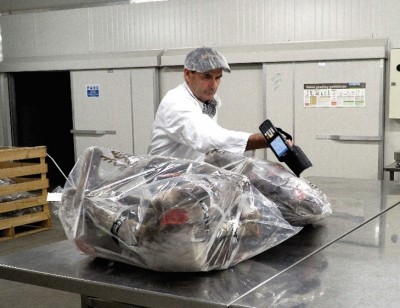
Velvet being scanned in a packhouse to generate an eVSD for farmer approval
VelTrak uses tags with a unique barcode and Ultra-High Frequency (UHF) Radio Frequency Identification (RFID) chip embedded in them, to identify sticks of velvet. This means that the tags can be scanned and the farm of origin rapidly identified, if needed.
The use of the UHF technology behind VelTrak is believed to be a first for the NZ pastoral sector. In contrast to low-frequency RFID systems that can only read one code at a time, UHF VelTrak tags allows tags to be read in bulk, which greatly speeds up the recording process.
DINZ QA general manager Rob Gregory, says VelTrak has been rigorously tested during its development. “However, we are always looking to further improve the system, so if a user discovers a bug, glitch or electronic gremlin lurking in VelTrak, please let us know, so that we can get it fixed.”
To use VelTrak, farmers, veterinarians, buyers and processors, must be registered. Registration meets the requirement for farmers selling their velvet into the human food chain. To register, ring DINZ.
VelTrak quick-start guides on their way: Starting this season, all deer farmers must tag their velvet with the new black VelTrak tags before sale. The buyer or receiver of their velvet will scan the tags and save the tag data to VelTrak, which will automatically create an electronic VSD for farmer approval.
To help farmers and farm staff get this right, DINZ has produced a VelTrak farmer quick-start guide as a wall poster, printed on washable synthetic paper. It’s being circulated next week by the National Velvetting Standards Body in their pre-season mailer to deer farmers.
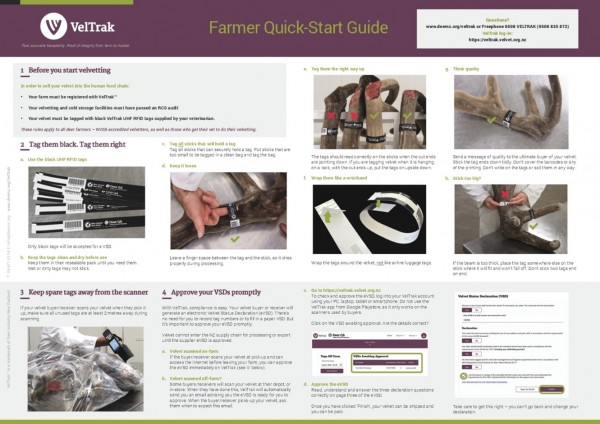
“Tagging and eVSD approval is straightforward. But we want the tags to look good on the velvet. The tags are quality marks. Like the label on a bottle of quality wine, they need to be clean, tidy and the right way up,” says Gregory.
With the eVSDs, the most important thing for farmers is to check and approve them as soon as they get an email saying an eVSD is waiting in their VelTrak account. Once a farmer has done this their velvet can be processed or packed for export.
And a new velvet grading chart: Also included in the NVSB mailer to deer farmers is a
new simplified velvet grading chart, the first update to the chart since 2013. Spare copies have also been supplied to velvet buyers.
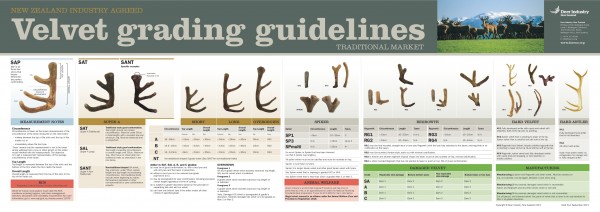
The Velvet Grading Guidelines Committee (a small group of velvet producers and buyers) recognised that some grades are no longer relevant and so have been removed: Taiwan, Spiker 2 and D Grade. A new grade, Spiker multi, has been introduced to cater for the growing quantity of spiker velvet with multi-tops. To qualify for this grade (as with any spiker grade), the tops must be round with no calcification whatsoever. The maximum beam length for SAT has been increased to 55 cm to reflect genetic progress in the last decade.
“Overall the grades have been simplified, but the purpose of the chart remains the same – to match like with like. To ensure that buyers and sellers are speaking the same language when they describe velvet. However they are guidelines only – some buyers will have customers who prefer velvet with different specifications,” says DINZ marketing manager Rhys Griffiths.
Another change is the addition of the words ‘Traditional market’ to the chart. Antler conformation is critically important to that market, which will always be a core customer of NZ velvet. On the other hand, healthy food customers are often interested in what’s going on inside the antler – the levels of bio-actives and so on. Griffiths says meeting the needs of those customers is likely to be the “next big piece of work for the velvet industry”.
Getting to know your number: The agriculture sector, through He Waka Eke Noa (HWEN), has a target that 25% of farmers will know their GHG (greenhouse gas) number and have a GHG management plan by the end of 2021. By the end of 2022 all farmers will be required to know their numbers. This is in preparation for agriculture having an emissions pricing regime in place by 2025.
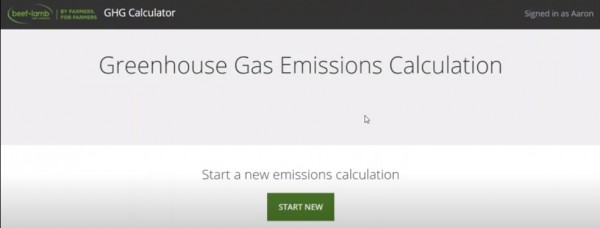
Already those deer farmers who are using Overseer will know their number, because it is generated automatically by the program. Farmax has a module that will calculate farm GHG emissions and there is the Beef+Lamb NZ online GHG calculator. But farmers will still need to complete a GHG management plan. For many, the best option will be to attend a ‘Know your number’ and GHG management plan workshop.
DINZ environment project manager Megan McCall has 15 trained facilitators to deliver these workshops to deer farmers. They will be using the Beef+Lamb NZ GHG calculator, which is free and provides for farmed deer. There will also be workshops organised by Beef+Lamb NZ that deer farmers may wish to attend.
The first DINZ workshops will be for Advance Parties and Deer Industry Environment Groups – 38 in all. These will run from late September to mid-December. From January, DINZ and the DFA will convene workshops for farmers who don’t belong to one of these groups. DINZ is also working with all venison marketing companies to help farmers know their number and develop a plan.
Who is He Waka Eke Noa? He Waka Eke Noa, translates roughly as ‘We’re all in this canoe together’. It’s a partnership of farming industry organisations, iwi/Māori and government, set up at the request of the farming industry to keep agriculture out of the New Zealand Emissions Trading Scheme.
 “We are working together to find ways to reward those farmers who reduce their emissions of methane and nitrous oxide, or offset them through increasing soil sequestration or additional tree cover,” says DINZ chief executive Innes Moffat (pictured).
“We are working together to find ways to reward those farmers who reduce their emissions of methane and nitrous oxide, or offset them through increasing soil sequestration or additional tree cover,” says DINZ chief executive Innes Moffat (pictured).
“The alternative is to apply a flat tax on all production, regardless of the work individual farmers do to reduce their emissions. In effect, those farmers who do the right thing would end up subsidising those who do nothing.”
If farmers can demonstrate that they know their GHG numbers and start working on plans to reduce them, it will help convince government and the rest of New Zealand that farmers take climate change seriously and are willing to do their bit to reduce emissions.
“If we don’t demonstrate that we are taking farm GHG emissions seriously, we’ll be faced with having agriculture put into the ETS, which will not work for us. No-one in primary industry wants that,” Moffat says.
For more about He Waka Eke Noa and why knowing your number is important, click here >>
Greenhouse gas pricing is coming – be prepared: Behind the scenes, a huge amount of work is being done by He Waka Eke Noa (HWEN) on greenhouse gas pricing options. It’s a complex task and the deadlines are tight.
Innes Moffat says DINZ is involved in this work alongside other primary sector groups. P2P manager Phil McKenzie is on the farm planning and delivery team and environmental stewardship manager Lindsay Fung is involved in the group that’s developing policy and pricing models. The topic will also be addressed by HWEN representatives at the upcoming annual NZDFA Branch Chairs & New Faces Conference from 11-12 October.
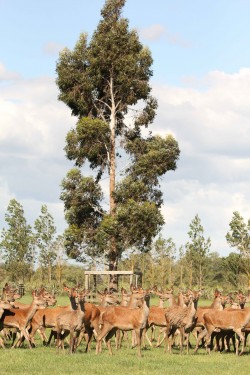 In November, HWEN will be releasing several pricing options for consultation. Farming groups will be expected to give their feedback by the end of December, with HWEN planning to report this to the government by March 2022 when the government will receive advice on how to address agriculture greenhouse gas emissions.
In November, HWEN will be releasing several pricing options for consultation. Farming groups will be expected to give their feedback by the end of December, with HWEN planning to report this to the government by March 2022 when the government will receive advice on how to address agriculture greenhouse gas emissions.
Federated Farmers, Beef+Lamb NZ and Dairy NZ will be holding farmer consultation meetings between October and November. Many farmers with deer are expected to take part in these meetings, but DINZ and the NZDFA won’t be officially involved. Moffat says the deer industry is unique and has its own distinct interests. “It’s important our voice is heard and is not drowned out by the views of larger industries.”
DINZ will therefore be consulting with deer farmers from the time HWEN releases its options for consultation until late-December. This will enable DINZ to report back to HWEN by the proposed 31 December deadline.
“We are fully aware that this will be happening at one of the busiest times of the deer farming year, but greenhouse gas pricing is going to impact on deer farmers’ bank accounts and the way they farm. So we strongly encourage all deer farmers to come up to speed with the GHG pricing options when they are released,” Moffat says.
Photo: HWEN is working on pricing models that allow livestock farmers to offset some of the GHG emissions from livestock with the carbon sequestered in shelter belts and riparian plantings.
DINZ budget out for consultation: The draft Deer Industry NZ budget for the 2021/22 financial year, starting 1 October, is now with the NZDFA executive committee and representatives of venison and velvet companies for feedback.
The consultation document proposed no change to levy rates for venison or velvet. There will be a draw-down of DINZ reserves in order to fund additional venison market development work to assist the recovery from the Covid-induced closure of restaurants.
“The feedback from levy-payers’ representatives is vitally important for us,” says DINZ chief executive Innes Moffat. “We need to ensure we are investing their funds in the areas of most importance.
“The DINZ Board recently confirmed the priority areas of DINZ activity and a stakeholder survey conducted by DINZ earlier this year reinforced the importance of the work on market development, quality assurance and advocacy on environmental regulation that DINZ undertakes on behalf of the industry. It has been reinforced to DINZ staff that venison prices are untenable at the moment and great care needs to be taken to ensure prudent use of the levy is maintained and activities must result in improved conditions for deer farmers.”
How widespread is this deformity? DINZ and AgResearch have a learning phase project underway looking at a condition known as the ’Angular Limb Deformity syndrome’. It is being led by Samantha Edgar, a veterinarian from Northern Southland Vets who has a special interest in deer. She is a member of the NZVA Deer branch committee and is on the DINZ research on-farm innovation steering group.
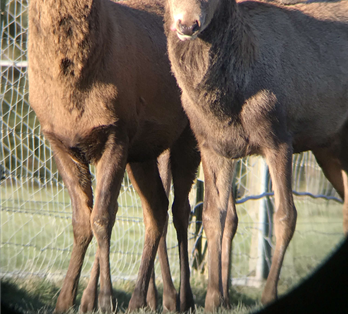 The syndrome occurs in spikers, and generally develops during the summer when the animal is around 12 months of age. The front limbs at the carpus (knee), become bowed or take on a knock-kneed appearance. The two presentations are shown in the photo.
The syndrome occurs in spikers, and generally develops during the summer when the animal is around 12 months of age. The front limbs at the carpus (knee), become bowed or take on a knock-kneed appearance. The two presentations are shown in the photo.
In the early stages, the animal may be lame, with the severity of the defect often getting worse over time. The condition can occur in both wapiti and red deer, and on venison and velvet farms.
“We would like to better understand the impact of the disease, from both welfare and economic points of view, and gauge its prevalence on NZ farms,” Edgar says.
If you have seen this condition (any year) please email samantha@nsvets.co.nz or phone her on 027 432 1045. All information and material collected will be treated in strict confidence.
Deer parasite manual on its way: Deer farmers should expect to receive an updated version of the Deer Parasite Manual in the mail shortly. The manual has been updated to incorporate advice on the use of Cervidae Oral, the first triple-active oral drench to be approved for deer. The update and reprint of the manual have been funded by Agritrade, the distributor of the drench.
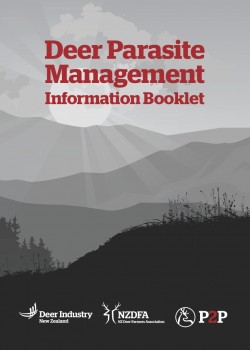 The three actives in the drench are mixed in ratios tailored specifically to deer. Deer host a different population of internal parasites to other species. They also metabolise the active ingredients in drenches differently. Cervidae Oral has a 28-day meat withholding period, unlike off-label drench mixtures which have 91 day WHPs, which make these brews impractical for use in commercial venison production.
The three actives in the drench are mixed in ratios tailored specifically to deer. Deer host a different population of internal parasites to other species. They also metabolise the active ingredients in drenches differently. Cervidae Oral has a 28-day meat withholding period, unlike off-label drench mixtures which have 91 day WHPs, which make these brews impractical for use in commercial venison production.
The triple-active formulation will help delay the onset of parasite resistance. Farmers can also help to ensure the longevity of Cervidae Oral, by using it infrequently, and by adopting farm management techniques that reduce the parasite challenge on pastures.
An updated version of the ‘Internal parasites’ Deer Fact sheet, including advice on the use of Cervidae Oral, was enclosed with the August/September edition of Deer Industry News.
Worried about TB infected possums coming across your boundary? As part of OSPRI’s work to eradicate bovine TB, they manage pest control operations in at-risk areas around the country. Large parts of the country are now free from bovine TB. So OSPRI no longer undertakes pest control work in those areas. Other agencies like DoC and Predator Free 2050 also do pest control work. You can check-out when the next OSPRI pest control operation is scheduled for your TB management area (TMA), here >>
Freshwater farm plan webinar on Monday evening: The Ministries for Primary Industries and the Environment are looking for feedback on the proposed freshwater farm plan system, the low slope map stock exclusion and intensive winter grazing regulations. These are topics that will affect deer farmers who winter crop, especially on heavier land and in high rainfall areas.
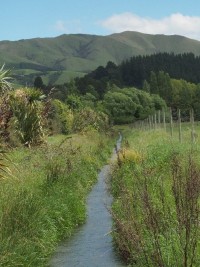 To help anyone who plans to provide feedback, officials are hosting a public webinar from 7.00-8.30 pm on Monday 20 September. To register, click here >>
To help anyone who plans to provide feedback, officials are hosting a public webinar from 7.00-8.30 pm on Monday 20 September. To register, click here >>
The webinar will give an overview of the topics and answer queries submitted in advance. The organisers will also endeavour to answer all queries submitted by participants during the webinar. Send through questions you already have to freshwaterfarmplans@mfe.govt.nz
For background material:
FW farm plan and discussion document and summary
Stock Exclusion: Proposed changes to the low slope map document >
Interactive stock exclusion map
Intensive Winter Grazing Discussion Document
Intensive Winter Grazing Discussion Document Summary
Order crop sprays early to avoid shipping delays: Covid-related shipping delays and disruption are causing significant issues for growers and farmers who rely on agrichemicals to establish or protect their crops. The lead time for products coming Australia is around 3-4 months – from countries outside Australia, about nine months.
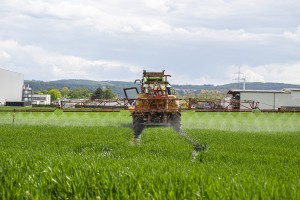 Unfortunately, slower deliveries are coming at greater cost. Price increases are expected to range from 3% to 60% depending on the product and where it comes from.
Unfortunately, slower deliveries are coming at greater cost. Price increases are expected to range from 3% to 60% depending on the product and where it comes from.
Agrichemical industry body AGCARM recommends that users should place their orders for agrichemicals three to six months ahead of when they would normally order them. It expects freight challenges to run into 2023 and says manufacturers and suppliers are factoring in a lead time of more than six months to acquire agrichemicals for the 2021-22 season.

